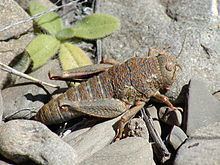Kingdom Animalia Family Acrididae Rank Species | Class Insecta Phylum Arthropoda Order Orthoptera | |
 | ||
Genus Brachaspis
Hutton, 1898 Similar Sigaus childi, Sigaus australis, Orthoptera, Tree weta, Anostostomatidae | ||
Brachaspis robustus is an endangered protected species of grasshopper from South Island, New Zealand. Two species of grasshoppers are listed for protection under the Wildlife Act 1953 of New Zealand this include B. robustus and Sigaus childi. Sigaus takahe is also protection under the Wildlife Act 1953 indirectly as it is only known from the Murchison Mountains Specially Protected (Takahē) Area. Brachaspis robustus is very distinctive from all other New Zealand grasshoppers as its escape behaviour is heavily dependent on its cryptic colouring and most time relies on motionless behaviour rather than active escape.
In 1993 it was estimated that were only approximately 800 adults in the wild. By the end of 2009/2010 summer it is estimated that the adults populations has decline to approximately 600 adults. Whereby in 1993, most adults were found in three key very large populations and only a few sub-populations, by 2010, numerous new sub-populations have been discover, however, the three key populations from 1993 are now very sparse and made up of numerous sub-populations.
The genus Brachaspis is endemic to the South Island of New Zealand.
Contents
Distribution and habitat
Brachaspis robustus is only known from the Tekapo River system in the Mackenzie Basin. It can be found as far south as the Lake Benmore (44°20′29″S 170°12′42″E) and as far north as the upper Fork Stream (43°58′24″S 170°24′04″E). Brachaspis robustus is known between 352 metres (1,155 ft) on the lower Ohau River and 1,060 metres (3,480 ft) the upper Fork Stream, but prefer altitudes between 400–700 metres (1,300–2,300 ft). Detailed searches since 1980 have been carried out throughout the Mackenzie Basin and a good understanding of it current distribution is now known. Brachaspis robustus is always found in very rocky areas (stony floodplain terraces, fluvio-glacial outwash, recent fluvial outwash and rocky braided river), and never found in vegetation.
Species description
The wings on B. robustus are micropterous (small wings) between 1–2 millimetres (0.039–0.079 in) making this species flightless like most of New Zealand grasshoppers. Male body length 18–22 millimetres (0.71–0.87 in); Female body length 38–42 millimetres (1.5–1.7 in). Males have 5 instars and female 6 instars this is identical to the other sub-alpine and alpine grasshopper species within New Zealand.
Type information
Polymorphism
Three colour morphs are known for adults B. robustus, 'Grey', 'Orange' and 'Black'. The must common form is the colour morphs 'Grey' at approximately 60% of the adults B. robustus, next is the colour morphs 'Orange' at 40% and the very rare colour morphs 'Black' at less than 0.5%.
Mating
The ratio of male to female B. robustus alter for the duration of New Zealand summer. At the start of the summer in November the ratio of male to female is 56% male and 44% female. The only time that female B. robustus will out number the male is in December where the ratio is 43% male to 57% female. For the remaining summer the ratio continues to favour a stronger male to female ratio. In January at 54% males to 46% female to in March it is 82% male and only 18% female.
Food habits
Brachaspis robustus is known to eat Anthosachne scabra (syn. Elymus rectisetus) and Poa pratensis, the herb Achillea millifolium, and unidentified mosses and lichens. Faeces analysed during spring suggested that moss and lichen are important for the dietary of B. robustus. This might reflect the dietary importance of moisture absorption by these plants at night. Food succulence is important in grasshopper diets, and mosses and lichens may provide a means of withstanding the aridity and drought of the Mackenzie Basin.
